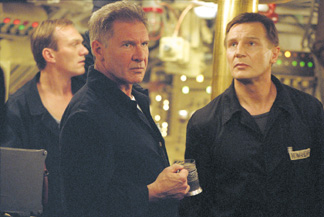K-19: The Widowmaker
Cold War Madness-and Heroism-Revisited
By Patrick Reed

"Harrsion, look sternly into the distance, and Liam, you look forlornly at the ceiling.
OK, great. And...action."
K-19: The Widowmaker is being heralded as an acting match between granite-jawed heavyweights Harrison Ford and Liam Neeson, but it also contains several lesser-publicized aspects that are of equal interest. It marks the wide-release return of director Kathryn Bigelow, who crafted a handful of visually arresting studio pictures during the late 80s and 90s. The film is based on an actual event, a seminal one for both submarine buffs and Cold War disciples-and a near-disaster that was concealed from Western eyes for nearly three decades. Lastly, K-19 marks the first foray into feature-film production from one of the twentieth century's most cherished periodicals, National Geographic, which has devoted an information-packed website to the film and all matters related to it.
While there has been a constant stream of movies about both submarines and the Cold War over the years, there's a lot of life left in both topics, and probably always will be. For relevance, consider: the ascent of former KGB functionary Vladimir Putin to president of Russia; the 10-year anniversary of the U.S.S.R.'s disintegration; and the horrific sinking of the Russian sub Kursk (death toll: 118), all occurring within the last two years. With such recent events as a backdrop, on K-19, producer-director Bigelow and screenwriter Christopher Kyle smartly focus on the central thrust of the real-life tale, which although it contains no actual combat-no "Fire torpedo one!"-is compelling all the same.
The time is June 1961, right on the heels of the Bay of Pigs fiasco and a year before the Cuban Missile Crisis-in other words, near the apex of Cold War superpower tension. Yuri Gagarin had barely bested Alan Shepard into space two months previous, but the Soviets were lagging behind in both submarine technology and overall missile capacity. As the film begins, the Russian navy is relentlessly building what will soon serve as the jewel of the Soviet submarine fleet, the nuclear-powered, missile-armed K-19. The plan is to have K-19 take to the Barents Sea north of Scandinavia as soon as possible and launch a ballistic test missile, so U.S. surveillance can witness the progress-but malfunctions keep occurring while the ship is still in dock. Captain Mikhail Polenin (Neeson) is demoted in favor of stoic hard-liner Captain Alexi Vostrikov (Ford) just before K-19 sets off on its historic maiden voyage, despite the fact that several people have already died on board-thus the vessel's unsettling nickname-and that Vostrikov is commanding a crew that doesn't respect him.
Early on, Vostrikov tests his crew's preparedness while submerged; they repeatedly fail, and soon begin to rally around second-in-command Polenin, who also chafes under Vostrikov's orders. Finally, a dangerous diving maneuver is successfully completed, followed by a rapid rise through the icecap to the surface and then the missile launch. Vostrikov makes a point about loyalty to Polenin and the dissenters and earns his crew's trust-but only temporarily, as it turns out. Orders from Moscow immediately come through, and K-19 heads southeast towards the Atlantic seaboard...but on July 4, near a NATO base off the coast of Greenland, one of the nuclear reactors on K-19 suffers a rupture in its coolant tubing, sending the reactor's temperature skyward and setting into motion the crisis that unfolds over the rest of the film. Unless the coolant system can somehow be manually repaired-which will expose nearly the entire ship to high doses of radiation-thermonuclear explosion is inevitable, possibly inciting World War III.
K-19: The Widowmaker may exhibit some of the same traits as The Hunt For Red October and Crimson Tide, but it's a more thoughtful picture (although less austere than the U-boat saga Das Boot). This movie mixes suspense with meditations on heroism and the madness of Cold War escalation; while the Soviet military infrastructure is unable to perfect and safeguard new technology due to the accelerated timetable, the individual seamen on K-19 rise to the occasion when tested, risking their lives in order to save their ship and stave off a potentially devastating confrontation. Hollywood rears its over-dramatic head once or twice (mainly via the sweeping musical score) and despite remarkable Soviet-era verisimilitude there's never any doubt that this is a thoroughly Americanized account of a Russian story-but overall K-19's embellishments aren't damaging. Harrison Ford (summoning some of that Tom Clancy gravitas) and Liam Neeson will rotate the turnstiles, but the real pleasure here is that Kathryn Bigelow is back making big-budget pictures. Say what you will about the plot of films such as Near Dark, Blue Steel, Point Break, and Strange Days-Bigelow knows how to make a story move visually, and even considering the claustrophobic setting, she's back in top form with K-19.
HOME | THIS ISSUE | ACE ARCHIVES